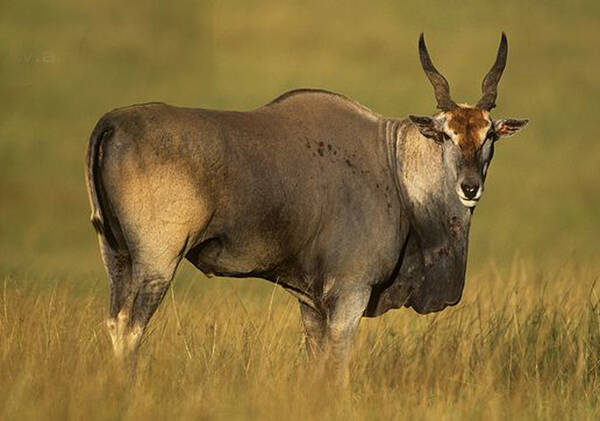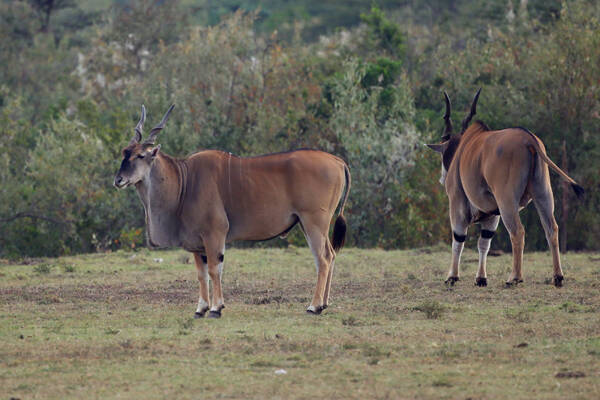Tragelaphus oryx
IUCN
LCBasic Information
Scientific classification
- name:Tragelaphus oryx
- Scientific Name:Tragelaphus oryx,Eland antelope, Eland antelope, Eland antelope
- Outline:Ungulata
- Family:Artiodactyla Bovidae Sapir
Vital signs
- length:200-280cm
- Weight:300-942kg
- lifetime:About 25 years
Feature
The fur is brown or tan with some vertical white stripes
Distribution and Habitat
Origin: Angola, Botswana, Democratic Republic of the Congo, Ethiopia, Kenya, Lesotho, Malawi, Mozambique, Namibia, Rwanda, South Africa, South Sudan, Swaziland, United Republic of Tanzania, Uganda, Zambia, Zimbabwe.
Regional extinction: Burundi.
The habitat of the antelope is mainly woodland and savanna, from coastal plains to mountains, from semi-deserts to areas with relatively high rainfall.
Appearance
The head and body of the antelope are 200-280 cm long, and the tail is 50-90 cm long; males weigh 400-942 kg, and females weigh 300-600 kg. It is one of the largest antelopes, similar in size to the Desmos. Their fur is brown or tawny with some vertical white stripes. Males are darker. As males age, the coloration on the neck and shoulders becomes slightly bluish-grey, and a short, dark mane runs down the back of the neck. Some also have white markings on the sides. A dew drop often hangs on the fur, which is thought to be an adaptation to high-temperature decomposition.
Both sexes have horns, which are 43-66 cm long. The heavy horns are twisted into a cork-like shape, with a slight twist from the base to the tip of the horn. The horns of males are stronger and have more obvious ridges than those of females. The hair on the forehead of males is dense, and the throat pouch is large. Adult male bushbucks can be identified by the loose skin under the throat and the long, coarse black h
Details
Common Eland (scientific name: Tragelaphus oryx) is also known as Common Eland or Eland in foreign languages. It has no subspecies.

The antelope is a social species that usually forms loose and mobile herds of 25-60 individuals, but can occasionally gather in groups of more than 1,000, especially during the rainy season. Adult males usually form herds, as do adult females, and young antelope females gather in brooding groups. In these herds, there is a hierarchy that determines access to food such as females and feeding sites. Males are not territorial, but can be possessive of receptive females.
The antelope is a herbivore, eating mostly leaves and shrubs and grasses, but also consuming fruits and seeds, and digging tubers, roots and bulbs in the ground. It is adapted to the arid conditions of many parts of Africa, feeding on juicy and water-rich food as long as there is a sufficient amount of it. It makes long-distance periodic migrations. It often drinks water where there is a water source, but can also go without water for long periods of time when water is scarce and obtain sufficient water from food such as leaves, roots and tubers. The antelope can survive in waterless areas as long as there are sap leaves. This is why, although the antelope is active during the day and night, it is most common at night when it is able to collect vegetation that absorbs moisture from the air and provides food with a higher water content. The antelope can also conserve precious water in its body by keeping its body temperature elevated during the day, reducing the need to sweat. As the sun sets, the body heat dissipates into the cooler night air.

The antelope reproduces in a polygynous system, with the dominant male mating with multiple females. Although mating and birthing may occur at any time of the year, mating is most common during the rainy season, and in some areas, there is a distinct breeding season. In Zambia, for example, young are born in July-August. The gestation period lasts 8.5-9 months, with a peak in births at the end of the dry season. Only one young is born per litter. Male young weigh between 28-35 kg, while female young weigh between 23-31 kg. Remaining hidden in the scrub and tall grass vegetation for the first two weeks of life, the young antelopes lie in hiding rather than staying with their mothers. Because the milk of the antelope is rich in nutrients, the young antelopes grow rapidly, and after 6 months they are weaned, and they soon join a small antelope trust. They reach sexual maturity at around 3 years old. The maximum lifespan is 25 years. Young antelopes often socialize in groups of antelopes of the same age.
Overhunting is the biggest threat to the antelope, which has led to its disappearance from many areas. However, the species is still widely distributed and survives in many protected areas, so it is not yet considered endangered.
The antelope lives entirely within protected areas, such as Kafue National Park in Zambia, Etosha National Park in Namibia, and the Cape Flower Reserve in South Africa, a World Heritage Site. In some countries, such as Malawi, the antelope is completely confined to national parks and game reserves. Therefore, continued protection of these areas is essential for the future survival of the antelope.
Listed on the 2016 IUCN Red List of Threatened Species, ver 3.1 - Least Concern (LC).
Protect wild animals and stop eating game.
Maintaining ecological balance is everyone's responsibility!








